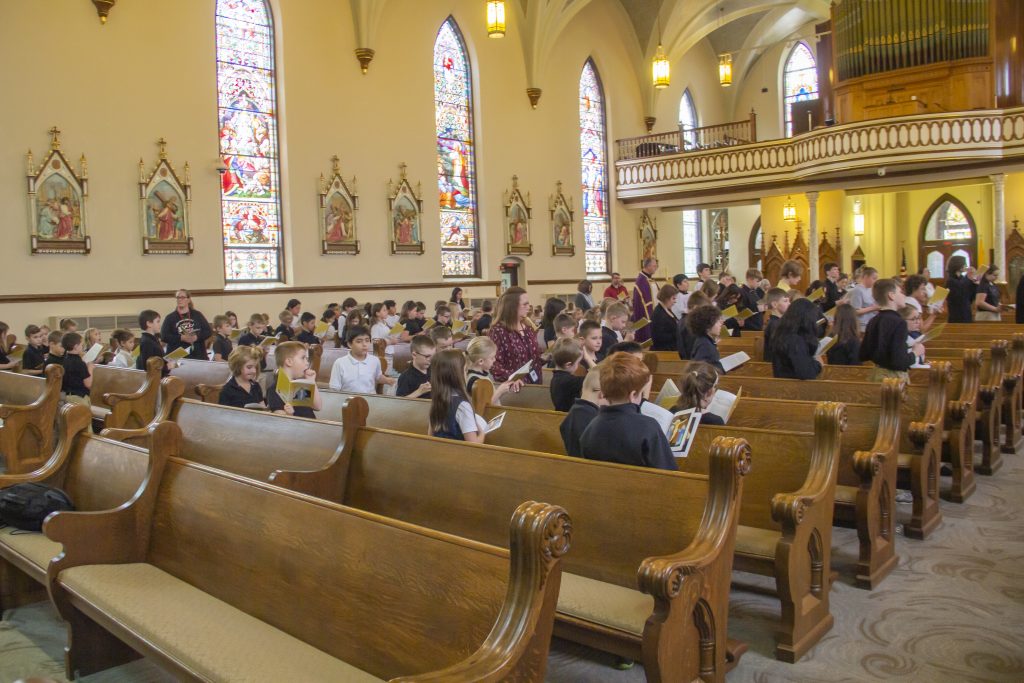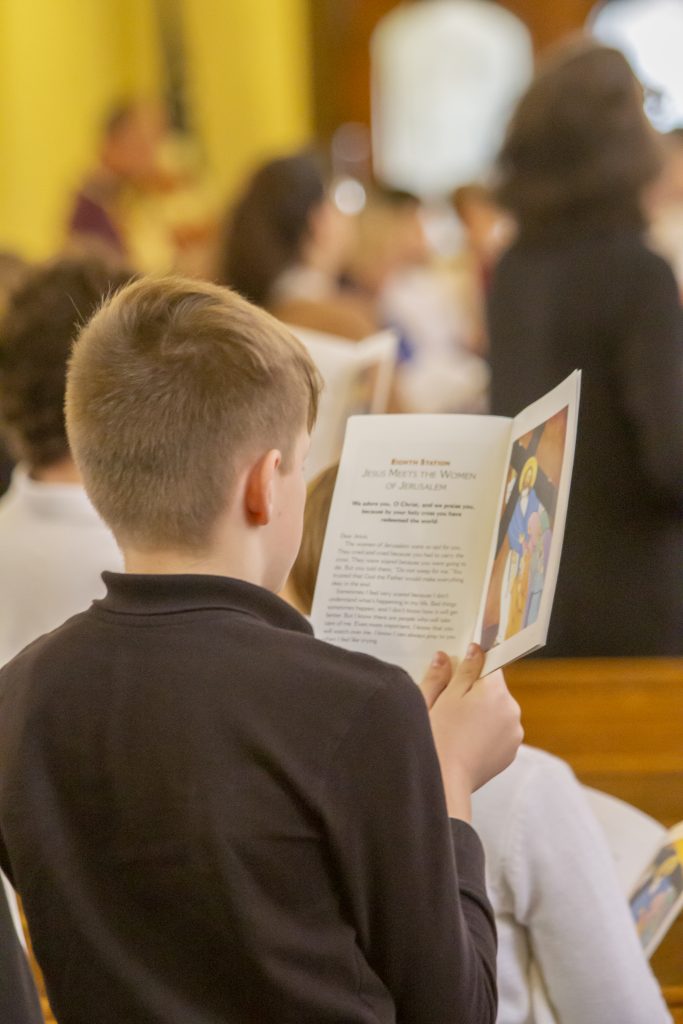March 24, 2022 // Diocese
Stations of the Cross a means of sharing Christ’s suffering
The Stations of the Cross, the mini-pilgrimage along the road to Calvary offered at most parishes on Fridays in Lent, reveals to its participants the very heart of Christianity. Not only do the Stations display the love of God for His people, but they also provide the answer to the fundamental problem within the human experience: the problem of suffering.
Click here for more photos from the stations at SS. Peter and Paul in Huntington.
Why are Catholics drawn to follow this journey of Our Lord? One reason is that most everyone finds value in stories; in narratives filled with drama, suspense, betrayal, and redemption. It is also known that Jesus was a real person who truly walked the streets of Jerusalem carrying a cross after being scourged and condemned to death by the Roman governor of the region, Pontius Pilate. If one were to walk along those roads today, one would see a rather similar experience to Jesus’ own time. The Via Dolorosa (Way of Sorrows) appears like many other streets in Old Jerusalem, filled with shops, vehicles, tourists, and plenty of commotion. Christian pilgrim groups on this walk garner similar attention from locals as Jesus did on the way to Calvary: very little. Yet those who choose to make this journey, whether in the streets of Israel or the churches of Indiana, realize that they have actually found the hidden, humble road of humanity’s redemption.

Photos by Joshua Schipper
Students at Huntington Catholic School recalled the Stations of the Cross at SS. Peter and Paul Parish in Huntington on Friday, March 18.
The pain and suffering each human being experiences at some point threaten to lead them away from belief and trust in a loving God. When people experience this pain and suffering in their lives, they can be tempted to think they do not deserve such difficulties, or that if God really loved them then He would take away their misfortunes. If one prays for God to remove their burdens and nothing seems to change, one can be faced with a real test of faith. Indeed, the problem of evil and suffering has troubled philosophers for millennia.
However, Jesus changes everything. The all-knowing God Who had often seemed eminently far away became wisdom personified in human flesh. We recall from the Christmas readings that the title Emmanuel literally means “God with us,” revealing that He came to dwell among mankind, to show once and for all time that humans are not alone in their mess, in their feelings of isolation, abandonment or adversity. Indeed, Jesus’ entire mission is one of redemption, to seek and save the lost – which encompasses everyone – by taking on human nature and restoring it to its original dignity. The way He does this is not simply through His birth – though it sometimes seems like Christmas is the high point of the year for many Christians. No, it is His paschal mystery – His suffering, death, resurrection, and ascension – that makes salvation possible. This is why we enter into His way of the Cross.
When Catholics walk the stations of the Cross, they can see God, the infinitely powerful Creator of all things, entering into the suffering others have created, and enduring it until He has given everything. Recall His unjust condemnation, the terrible burden of carrying that cross, the falls along the way, the encounters with His mother, Simon, Veronica, the women and others. Ponder the reality of the stripping, the nails, His seven last cries from the cross and His death. Meditate on the depths to which God knows exactly what His people are going through – from His own personal embodied experience. He came to endure it for His people, with them and alongside them – that they might never again feel desolation, despondency or despair.
If a person is tempted to think that their suffering is undeserved, they need only look at what He suffered. His pain was completely unjust, yet He willingly undertook it out of love to provide a path out of brokenness.
If one is tempted to think less of His self-gift, one must recall the magnitude and consequences of the Original Sin and the reality of one’s personal sins – remembering that the just punishment for even one mortal sin is – potentially eternal – separation from God. Yet Christ took the full burden of humanity’s sins so that all may have a way back to full communion and restoration with the Father. As Archbishop Fulton J. Sheen wrote, “Every other person who ever came into this world came into it to live. Christ came into it to die.” He came that we might be made new.
While most experiences of this journey end with the darkness of the tomb, recognize that even in our churches, the 14th Station is not the end. The Christian way continues to the 15th Station, found at the front of the church: that of the risen, living Jesus, Whose pierced Heart is alive and beats once again in the tabernacle. In the Church of the Holy Sepulcher in Jerusalem, at the place where Our Lord’s Body rested in the tomb, is an altar where the Holy Sacrifice of the Mass is offered as a perpetual reminder that God’s love is stronger than death and that His promises are true.
St. Faustina wrote that, “If the angels were capable of envy, they would be so for two reasons: Holy Communion and suffering.” This could seem rather paradoxical or misguided, but this Polish mystic understood that the fundamental identity of God is Communion, as a Trinity of Persons. And while the sacraments allow Catholics to share in God’s divine life, suffering worthily and courageously allows them to imitate our Blessed Lord.
Everyone has been in Pilate’s shoes. All have sinned like the soldiers. All have stood back like the bystanders. All have been the people who didn’t notice Jesus or care about Him. Today, in a new way, everyone is invited to see Him, walk with Him, help Him carry the cross and alleviate His suffering by reverently caring for His body – both in the Eucharistic host and in the host of neighbors around us.
Many Catholics have come to connect the 3 o’clock hour with Divine Mercy thanks to St. Faustina. It is worth reflecting upon what Jesus told her about this time: “I remind you, My daughter, that as often as you hear the clock strike the third hour, immerse yourself completely in My mercy, adoring and glorifying it; invoke its omnipotence for the whole world, and particularly for poor sinners; for at that moment mercy was opened wide for every soul. In this hour you can obtain everything for yourself and for others for the asking; it was the hour of grace for the whole world — mercy triumphed over justice. My daughter, try your best to make the Stations of the Cross in this hour, provided that your duties permit it.” He also reminds her, “Do not be afraid of sufferings; I am with you.”
The best news. Delivered to your inbox.
Subscribe to our mailing list today.







